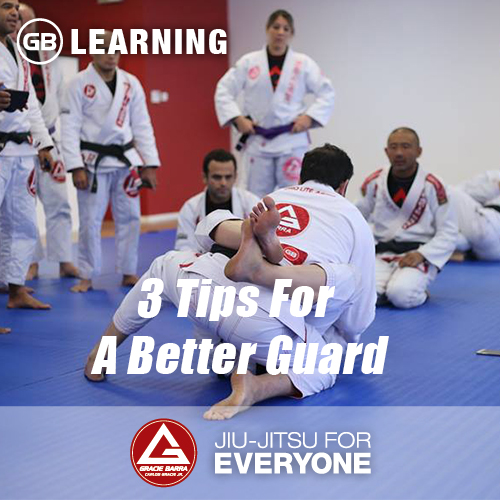3 Tips For A Better Guard

Since 50% of your training time in jiu-jitsu you will be working from the bottom, your guard is super important. The sophistication of the guard position is the most significant difference between jiu-jitsu and the other world grappling arts.
Having a great guard game is partly about having an arsenal of submissions but there are also the additional factors of guard retention and replacement. That is to say your ability to move and counter your opponent’s passing attempts. This is an underappreciated aspect of having a strong guard.
Your instructor can teach you the various different styles of guard and the key techniques from each. “The right tool for the right job” means that you need to use different guard styles depending on the range of your opponent.
Example : Butterfly guard would be effective to deal with a close passing opponent while De la Riva guard would be better to deal with a standing passer.
There are a few guard position principles that Black belts have shared with me that were helpful in tying those techniques together into an effective guard game.
1) Attack!
One of the best pieces of advice on playing guard I got from the most dangerous guard fighter in my academy. His advice was simple “Be the first to attack! Don’t wait to see what your opponent is going to do.”
If you can immediately start to threaten the passer with a sweep or break the posture or control the elbow for an arm bar, the passer must immediately stop their pass attempt and defend your attack.
When the passer is constantly defending one attack after another attack, they have little opportunity to start their own offence.
2) Get a grip
The old school Helio Gracie hand in the collar guard is doubly effective because it accomplishes 2 things at the same time:
A) It breaks the posture of the opponent making it difficult to pass
B) Threatens the choke which creates submission combinations when the opponent defends the choke
When you can establish the grips that you want, you have an advantage in controlling your opponent. Ideally, those favorite grips ex. Spider guard sleeve grips lead directly to your most dangerous triangle submission attack.
On the other side of the grip battle, denying your opponent’s passing grips is a skill that we witness in high level competition by the guard player.
3) Move your hips!
How often during a roll have you heard your instructor shout “Move your hips!”?
Too many times to count!
The ability to manage the space between the guard player and the passer is every bit as important as whatever grips you may get. Watch a black belt roll and observe how often they make adjustments to position by moving the hips from one side to the other.
We are accustomed to using our arms to perform most of our tasks in daily life and we must learn how to use our legs and hips. This is why performing various drills (like shrimps and hip escapes) are so important early in our jiu-jitsu training.
Lastly, focus some if your training time on guard retention and replacement movements. This is a hugely important yet often neglected part of having a great guard.
See also on Gracie Barra : Single Best Piece Of Training Advice
https://graciebarra.com/2016/06/single-best/
Credits: Mark Mullen
Gracie Barra Black belt based in Saigon, Vietnam
Instagram: @bjjmarkmullen
